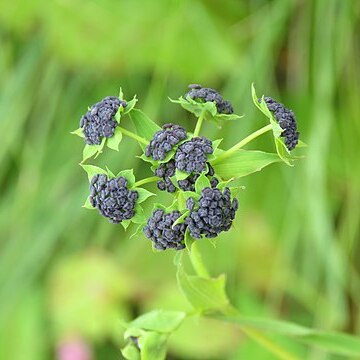Plants 40–100 cm, perennial. Taproot stout, woody, branched. Stem erect, much-branched above, branches spreading-ascending, base without fibrous remnant sheaths. Lower leaves linear-lanceolate or long-elliptic, 12–15 × 0.5–0.8 cm, 11–15-nerved, abaxially glaucous, apex rounded-obtuse, apiculate. Upper leaves long-obovate, base cuneate. Umbels 2.5–4 cm across; bracts 3–5, ovate, 3–20 × 2–10 mm, unequal; rays 4–8, 1–3 cm, unequal, slender; bracteoles 5, broadly elliptic or suborbicular, 3–6 × 1.8–4 mm, apex rounded, apiculate, greatly exceeding flowers; umbellules 8–12 mm across, 10–15-flowered; pedicels 0.5–1.5 mm. Petals pale yellow or dark purple. Stylopodium low-conic, discoid, dark yellow or dark purple. Fruit oblong, brown, 2.7–3.5 × 1.7–1.9 mm; ribs prominent, narrowly winged; vittae 3 in each furrow, 4 on commissure. Fl. Jul–Aug, fr. Sep–Oct.
More
An erect herb. It keeps growing from year to year. It grows 40-100 cm tall. The taproot is stout and becomes woody. The stem is erect and branched above. The lower leaves are narrow and 12-15 cm long by 1 cm wide. The upper leaves are wider and have a wedge shaped base. The flowers are yellow. The fruit are oval and they have ridges along them. They are 5 mm long.
It is a temperate plant. It grows between 2500-4000 m altitude in Uttar Pradesh in India. In China SW China it grows on shady slopes between 1,800-3,200 m above sea level.
More
Mixed forests on shady slopes, open forests, mountain slopes, grassy places; at elevations from 1,800-3,200 metres.

